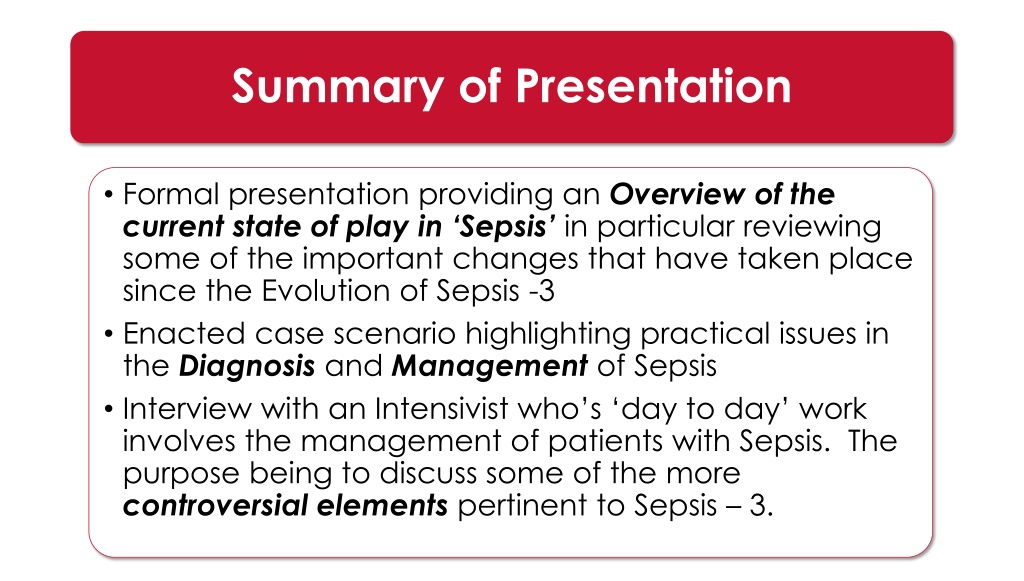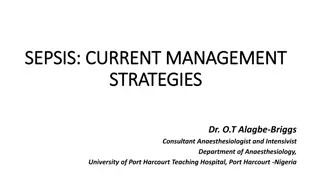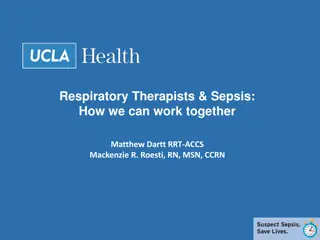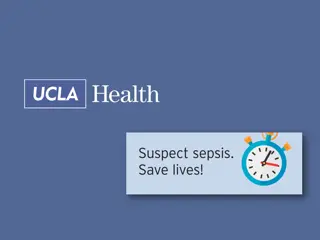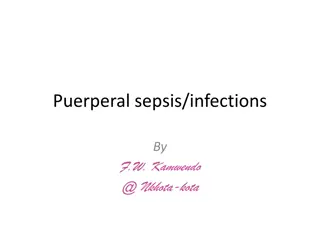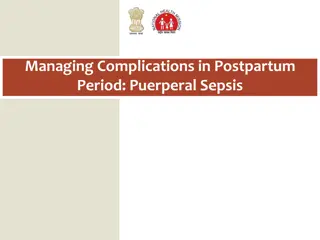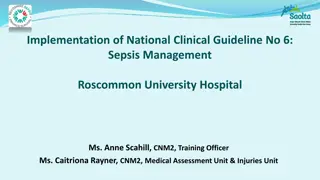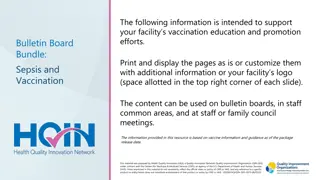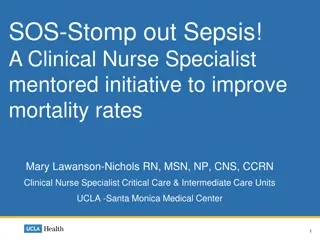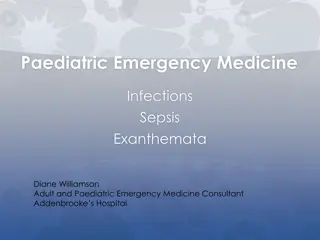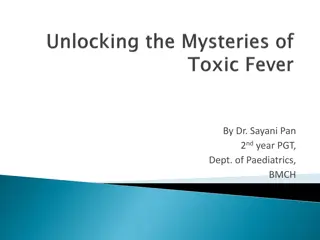Overview of Evolving Sepsis Landscape
This formal presentation delves into the current state of sepsis, highlighting key changes post-Evolution of Sepsis-3. It encompasses case scenarios, diagnosis challenges, and an intensivist interview to address controversial aspects. It covers definitions evolution, epidemiological trends, both infectious and non-infectious causes, and a glimpse into sepsis pathophysiology. Insightful images complement the narrative, enriching the understanding of this critical medical condition.
Download Presentation

Please find below an Image/Link to download the presentation.
The content on the website is provided AS IS for your information and personal use only. It may not be sold, licensed, or shared on other websites without obtaining consent from the author.If you encounter any issues during the download, it is possible that the publisher has removed the file from their server.
You are allowed to download the files provided on this website for personal or commercial use, subject to the condition that they are used lawfully. All files are the property of their respective owners.
The content on the website is provided AS IS for your information and personal use only. It may not be sold, licensed, or shared on other websites without obtaining consent from the author.
E N D
Presentation Transcript
Summary of Presentation Formal presentation providing an Overview of the current state of play in Sepsis in particular reviewing some of the important changes that have taken place since the Evolution of Sepsis -3 Enacted case scenario highlighting practical issues in the Diagnosis and Management of Sepsis Interview with an Intensivist who s day to day work involves the management of patients with Sepsis. The purpose being to discuss some of the more controversial elements pertinent to Sepsis 3.
Changes In Definitions Based on the Consensus of the ESICM and SCCM [February 2016] SIRS SEVERE SEPSIS SEPSIS REDEFINED - Life threatening Organ Dysfunction caused by a dysregulated Host Response ORGAN DYSFUNCTION Change in Baseline Sequential Organ Failure Assessment [SOFA] SEPTIC SHOCK Subset of Sepsis in which underlying circulatory and cellular metabolic abnormalities are profound enough to increase Mortality
Epidemiology Incidence increasing [0.4/1000 to 1/1000] Mortality decreasing [28% to 18%] Australasian study Prospective collection of 90% all ICU admissions between 2000 - 2012 confirmed these trends Increase in Incidence of Severe Sepsis [7.2% to 18%] Decrease in Mortality [35% to 18%] Despite a more clear understanding of the Pathophysiology no translation to the development of specific drug therapies.
Epidemiology cont. Lower incidence of Severe Sepsis in Females Higher incidence in African/American population Incidence increases with AGE Incidence increases in IMMUNOSUPPRESSION and CANCER Genetic Variants Modifiable risk factors
Non-Infectious causes Pancreatitis Tissues Ischaemia Trauma Burns Thromboembolism Vasculitis Drug reactions Autoimmunity Neoplasia
Infectious Causes - EPIC II Data Site Incidence Lungs Intra-abdominal Bloodstream Genitourinary System 64% 20% 15% 14% Bacteria/Organism Isolates Prevalence Gram +ve Gram ve Fungal 47% 62% 19%
Pathophysiology Organ and Tissue Level Increase in Cardiac Output Decrease in Systemic Vascular Resistance [i.e. profound peripheral arteriolar vasodilatation] Increase in Serum Lactate 2 Theories for Increase in HyperLactaemia Hypoperfusion/Hypoxia Aerobic Glycolysis through enhanced adrenergic tone
Pathophysiology Endothelium and Sepsis Increased Leucocyte Adhesion Increased Coagulation Vasodilatation Loss of Barrier Function Hypercytokinaemia
Pathophysiology Organ Manifestation Disseminated Intravascular Coagulation Bacterial Translocation ARDS AKI Encephalopathy Hepatic Failure
Sepsis-temporal Sequence Early Pro-inflammatory state Prolonged state of Immune Dysfunction Secondary vulnerability to microorganisms
Sepsis Cycle ARDS Lung Injury SEDATIVES Severe Neuromuscular weakness Reduced Mobility/Progressive Catabolism/ INTESTINAL BARRIER DYSFUNCTION Ongoing Bacterial Translocation and Malnutrition IMMUNE DYSFUNCTION Secondary Infections
Sepsis Cellular/Molecular Level ENDOTOXIN PRODUCTION MACROPHAGE CYTOKINE INFLAMMATORY SIGNALLING PAMPS[Pathogen Assoc. Molecular Patterns/DAMPS [Damage Assoc. Molecular Patterns]/INFLAMMASOMES POTENT CYTOKINE RESPONSE TNF- , IL1, IL6, IL1 & IL18 PYROPTOSIS Caspase mediated Plasma Membrane rupture
Sepsis Cellular/Molecular Chain of Events EARLY DAMAGE PATHWAY Reactive Oxygen species e.g. Nitric Oxide Complement Activation C5a Immunothrombosis METABOLIC DYSFUNCTION Decreased ATP concentrations Cell Hibernation Retained Oxygen tension Increased Catabolism RESOLUTION PATHWAYS Compensatory Anti-Inflammatory Pathways IL-10 TGF-
Sepsis - Treatment The Key to successful treatment of SEPSIS is EARLY RECOGNITION and EARLY INTERVENTION
Novel Targeted Molecular strategies have been largely unsuccessful
Sepsis - Treatment SEPSIS 6 IVI - crystalloids BS Antibiotics Oxygen therapy Urine measurement Blood Cultures Serum Lactate Early and Effective Antimicrobial therapy Resuscitation Fluid Type/ Resuscitation Volume/Resuscitation adequacy Timing and Choice of Vasopressors Transfusion Threshold
Treatment Other Supportive Measures Lung Protective ventilation Restricted Fluid therapy Reduction in sedative use Improvement in the design of catheters and tubes Nutritional Support
Conclusions - Sepsis Ubiquitous and increasing in frequency Complex condition which is expensive and deadly Pathophysiology of this condition is intricate yet hypnotic for all who study it. Specific molecular targeted therapies have been phenomenally underwhelming Early recognition and expedient intervention is key Less is More moderate intervention i.e. fluids oxygen therapy sedatives Novel therapeutic strategies may be better studied with the new consensus Sepsis 3 constraints in place
Summary of Ongoing Trials and Bibliography Gotts JE et al. Sepsis: Pathophysiology and Clinical Management BMJ 2016;353:1585-1605. Singer M et al The 3rdinternational consensus definitions for sepsis and septic shock [Sepsis-3] JAMA 2016;315:801-10. Tarrant C et al. A complex endeavour an ethnographic study of the implementation of the Sepsis 6 clinical care bundle Implementation Science 2016;11:149-160 NICE Guidelines Sepsis: recognition, diagnosis and early management 2016; nice.org.uk/guidance/ng51.
